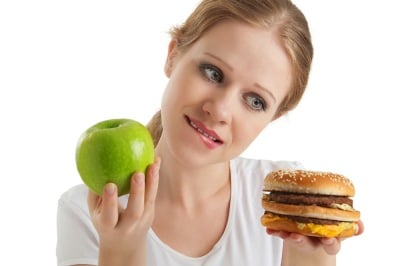The counting of calories and kilojoules can be a most effective method of weight control, writes DietDoc. Many people, however, don't understand how to use this tool correctly to lose weight and keep their weight in check. Here's help.
What is a ‘calorie’?
The word "calorie" is written in inverted commas because it is not strictly correct to speak about "calories" in South Africa for two reasons:
- Firstly South Africa is a country that uses the Metric System of Weights and Measures (e.g. kilogram, kilometre and Kilojoule (kJ)) and "calories" are non-metric units that are used to measure how much energy we use up every day and how much energy we consume when we eat food and drink drinks.
- Secondly "calories" come in two sizes - the little calorie and the Big Calorie which is actually called the kilocalorie or kcal. When we talk about food energy and energy used up during exercise we are talking about Big Calories or kcal.
Let’s try to think of the non-metric unit of energy as a Kilocalorie which is abbreviated as kcal so that I don’t get into hot water. I know full well that most readers think and talk about calories and not kilocalories, but to be correct and scientific let’s keep in mind that in the fields of Nutrition and Dietetics, the non-metric unit of energy is the Kilocalorie or kcal. The kcal is used in countries such as the USA.
A calorie (with a small ‘c’) is defined as “the amount of heat energy required to raise the temperature of 1 ml of water at 15oC by 1oC”. (Mahan et al, 2011). But when it comes to measuring how much energy is in a food or how much energy we use up when we run the Comrades, we tend to speak about very large quantities of energy which is why the boffins decided on the concept of the kilocalorie (kcal). Each kcal = 1000 cal, so it is a really Big Calorie.
What is a ‘kilojoule’?
As mentioned above, South Africa is a metric country and all our units are metric ones. Thus the energy in food and the energy we expend doing exercise is measured in units called kilojoules (abbreviated as kJ). The ‘joule’ (small unit of energy) is defined as “the amount of energy expended in applying a force of 1 Newton through a distance of 1 metre” (Mahan et al, 2011). The kilojoule or kJ is a Big Joule and represents 1000 joules.
At the end of the day, it is important to remember that we measure the energy in food and the energy we use up just by living and also by doing exercise in terms of kcal (non-metric) or kJ (metric).
How many kcal in one kJ?
If we have two different systems of measuring energy and two different units for expressing energy, namely the kcal and kJ, then how do they relate to each other?
The basic rule is that 1 kJ = 4.185 or 4.2 kcal.
So when we talk about how many kcals you can eat a day and want to convert them to kilojoules, you multiply the kcal by 4.2.
For example, if an adult woman who is moderately active needs 2000 kcal a day to maintain her weight and provide sufficient energy for her to keep going, then in terms of kilojoules, she needs:
2000 x 4.2 = 8400 kJ
On the other hand if you would like to convert kJ to kcal then you divide by 4.2
The above mentioned woman who ingests 8400 kJ of energy would need:
8400 ÷ 4.2 = 2000 kcal a day to sustain her weight and activity.
(Also check out Health24's handy Calorie Converter)
Should we count calories or kilojoules?
Many people who want to lose weight start off by counting calories or kilojoules, but if the latest results of a study conducted in America by the Dietary Guidelines Alliance are to be believed then many consumers in the USA do not understand calories and need to be taught how to use them to keep their weight in check (NNIA, 2012). The same probably applies in South Africa.
Interaction with the public indicates that while some people are fanatical about counting kcal or kJ to the second or third decimal place, the majority of South Africans could not be bothered to even try.
I am personally of the opinion that counting kcal or kJ can be a most effective method of weight control, but that there are other methods that can be applied just as successfully to achieve excellent weight loss. For example, teaching slimmers what portion sizes they can eat or how to reduce fat intake or encourage them to become more active, are all strategies that may work well for one person and not for another. An individual approach to weight loss appears to be important if you want to achieve significant results.
Kilocalories and kilojoules are not mysteries, but ordinary units used to measure how much energy we take in and how much energy we use up on a daily basis. Let’s learn how to use them properly.
Click here for DietDoc's 10 tips to lose weight.
- (Dr IV van Heerden, DietDoc, May 2012)
(Photo of woman choosing between apple and hamburger from Shutterstock.)
References:
(Government Gazette, (2010). Nutrient Reference Values (NRVs). Regulations Relating to the Labelling & Advertising of Foodstuffs. No. R. 146. Foodstuffs, Cosmetics & Disinfectants Act, 1972 (Act 54 of 1972). Government Gazette. Np. 32975, 1 March 201. Gov Printer, Pretoria; Mahan LK et al (2011). Krause’s Food & the Nutrition Care Process. Ed. 13. Elsevier, USA.; NNIA, 2012. Many consumers do not understand calories.)
Any questions? Ask DietDoc
Read more:
Dieting - cut the confusion
How much weight should you lose?
The ultimate slimming guide




 Publications
Publications
 Partners
Partners











